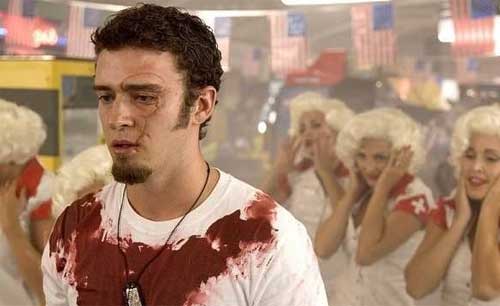Director:
Michael Crichton
Released:
1973
Starring:
Yul Brynner, Richard Benjamin, James Brolin, Norman Bartold, Alan
Oppenheimer, Victoria Shaw, Dick Van Patten, Linda Scott, Michael
Mikler
Plot:
In the near future a high tech amusement park has been created in
which guests can act out their fantasies in one of the three
“worlds”. However when the park androids begin to malfunction
they soon start to turn on the guests.
Review:
While Michael Crichton might be best known as a writer, having given
us the likes of Congo, Jurassic Park and Disclosure he is should be
equally recognised for his work as a director with this film not only
marking his debut as a director but also the first film to use 2D
computer imagery.
Opening
with a reporter greeting returning Delos guests sharing their
experiences of playing knights or cowboys, engaging in shoot outs and
marrying princesses before we are shown the introductory video to the
resort which outlines the three worlds they have created West World
(Wild West), Medieval World and Roman World with each promising their
own experiences within their lifelike settings. We also meet Peter
(Benjamin) and his friend John (Brolin) who are both paying $1,000
per day to live out their cowboy fantasies despite Peter being
sceptical about the whole experience.
In many
ways a test run for “Jurassic Park” as here we get another
hi-tech park suffering a major malfunction, only this time instead of
rampaging dinosaurs we get homicidal androids who’ve forgotten the
fact that they aren't supposed to be killing the guests. The idea
behind the parks though is fantastic with guests being free of any
kind of moral quandary over the actions they make thanks to the park
being staffed with android actors for the guests to engage with as
well as seduce and kill. This of course is just what Peter and John
want of course as they play out their gunslinger fantasies, while
casually giving a thought to joining in a bank robbery while they
hook up at the local brothel.
The
androids in the three worlds all play a variety of roles, while
programmed to respond to the guests or provide cues to engage with
them in shootouts or romantic dalliances, while going into a state
where they just repeat themselves if a guest misses their cue,
bringing back memories for myself of the restaurant scene in
Cronenberg’s “Existenz”. Yul Brynner is unquestionably
brilliant as the gunslinger as he essentially plays the android
version of his character in “The Magnificent Seven” and perfectly
projects a cold and emotionless exterior, only ever showing emotion
when he’s running through one of his scripted lines and as a result
gives us the perfect villain of sorts for the film and in many ways a
forerunner for the unrelenting killing machine that James Cameron
gives us in “The Terminator”.
Unlike
“Jurassic Park” the issues with the park here aren't caused by
sabotage but instead a technical breakdown that the technicians can’t
resolve because they don’t fully understand how the technology
actually works. The lead up till the collapse of the park though is
subtly done as more of the androids start to malfunction as we build
up to the final chase between Peter and the unnamed android
gunslinger (Brynner) as he tries to escape through the other worlds.
it’s during this build up we also get to see hints of the inner
workings of the park as a team of engineers work through the night to
reset scenes and clean up shoot out’s the guests seemingly none the
wiser of the work they are carrying out to maintain their fantasies.
While
Westworld might be the main focus, Crichton also gives us passing
glances of the other worlds, mainly to show how the breakdowns are
spreading across the park and possibly as an excuse to work a sword
fight into what is essentially a sci-fi western with one of the
guests engaging in a length battle with the medieval world villain
who unsurprisingly is “The Black Knight” the same as Westworld’s
black clad gunslinger. Sadly we never get to see who the villain of
Roman world is.
While
Peter and John might initially be setup as being the heroes of the
film, here Crichton instead does something unexpected as he follows
the pair on their cowboy fantasy only to in the finale suddenly have
one of them suddenly and unexpectedly shot dead leaving the survivor
to spend the final 15 mins running away from the Gunslinger. It’s
an unexpected ending especially when it doesn’t see either of our
supposed heroes stepping up and becoming the hero they are playing at
being.
A
strightforward story which throws out some intresting ideas and ones
which Crichton obviously explored further with “Jurassic Park”,
while a sequel “Futureworld” and a short lived series “Beyond
Westworld” attempted to expand the world further with little
success and while the forthcoming HBO series aims to take another
crack at this world this remains a fun curiosity if ultimately too
disposable to be considered high sci-fi.

























